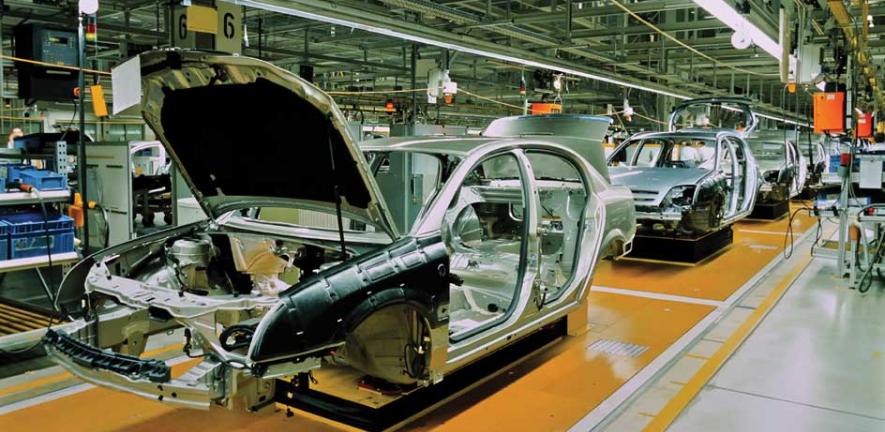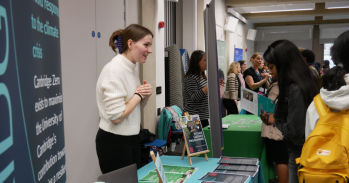
Threats that cause supply chains and other networks to break down can cascade through today’s interconnected world of social, economic and financial interaction. New research is redefining this global risk to help businesses and governments build resilience.
Threats that cause supply chains and other networks to break down can cascade through today’s interconnected world of social, economic and financial interaction. New research is redefining this global risk to help businesses and governments build resilience.
This is a very new area. Catastrophe science is a multi-billion dollar industry that’s been around for a few decades, but putting it together with network analysis has not been done before.
Dr Andrew Coburn
Many of us will never have heard of PA-12. But when an explosion in a factory in Germany on 31 March 2012 halved its global source, this little-known component of car fuel lines gained notoriety by threatening production in the automotive industry. It’s a scenario that had already been played out twice in the preceding year when specialised automotive parts became scarce following the Tohoku earthquake and tsunami in Japan, and following a factory fire in the USA.
The tale of PA-12 demonstrates the fragility of global supply chains but is not altogether a surprise. Businesses understand the risks inherent in globalised supply chains that might be affected by natural catastrophes, geopolitical conflicts, disease outbreaks, trade disputes and so on. But what might be less obvious is how interconnected are the networks of relationships of trade, business and macro-economics, and how quickly the effects of a catastrophe can cascade.
“It used to be the case that catastrophes on the other side of the world had little economic impact on the UK,” explained Dr Andrew Coburn, researcher in the Centre for Risk Studies at Cambridge Judge Business School, “but in today’s interconnected world, few countries are isolated from the knock-on effects of catastrophes, whether it’s a freeze in Europe, piracy around the Horn of Africa or a pandemic in Asia.”
Coburn is also Senior Vice President at Risk Management Solutions (RMS), the leading provider of catastrophe risk models to the insurance industry. By modelling risk to extreme events, he has provided research inputs into government policy on disaster mitigation and terrorism risk management policy. Now, a research programme that he leads at the University of Cambridge aims to provide new understanding of how socioeconomic risks (or ‘system shock’) can not only damage supply chains but also disrupt the networks that keep our lives going.
The programme, which is funded by Deloitte, the Institute of Catastrophe Risk Management at Singapore’s Nanyang Technological University and RMS, has taken the ambitious step of combining catastrophe science with systems analysis. It’s a challenging but high-gain move, as Coburn explained: “This is a very new area. Catastrophe science is a multi-billion dollar industry that’s been around for a few decades, but putting it together with network analysis has not been done before. We are having to start with the nuts and bolts and develop a new methodology.”
Part of this methodology, developed in collaboration with Nanyang Technological University, has been to derive a list of threats. Working with colleagues at Cambridge’s Centre for Financial History, the researchers have taken a remarkably long historical perspective, as Research Associate Dr Gary Bowman explained: “Analysing events from only the recent past can paint quite a misleading picture. We’re taking a 1,000-year perspective that allows us to be much more rigorous in terms of assessing the frequency of events and the resulting effect. In fact some of the best examples of threats such as asset crashes can be found in the 17th and 18th centuries – in the Amsterdam Tulip bubble and the South Sea bubble for instance.”
The result is a systematic taxonomy of socioeconomic threats that could conceivably threaten human and financial capital, damage assets and disrupt the systems that support our society, at either a national or an international level.
With the help of a peer review process involving risk professionals, academics and corporate advisory groups, the researchers have captured 12 broad types (broken down into 47 subclasses) of the most significant threats that could interrupt a major region’s normal life patterns, wipe more than 1% of a country’s GDP, or, where applicable, kill more than 1,000 people or cause a loss of assets or infrastructure amounting to $10 billion.
Over time, the Centre for Risk Studies plans to expand their research website (systemshock.org.uk) to provide state-of-knowledge illustrative scenarios for each of the 47 subclasses of threat; already five are in preparation. The scenarios are objective, transparent, evidence-based, useful in business decisions and available to the risk management community.
“For piracy, for instance, we are reviewing all of the instances of piracy in the Horn of Africa and factoring in the cost to shipping,” explained Bowman. “We’ll then ask at what point does the threat become so significant that the system starts to adapt – shipping lanes change or a military presence protects commerce in the region.”
In parallel, for each scenario, Professor Danny Ralph is coordinating research on what system shock means for the automotive, pharmaceutical and electronic industries, each of which has a highly interconnected global network: “Where we think we can add value is to take what businesses understand well – their markets, components and contractors – and set alongside it a higher level framework of system shock.”
The System Shock project is part of the Cambridge Risk Framework research project at the Centre for Risk Studies, a multi-disciplinary centre for the study of societal and economic risks. “We believe the Centre has a unique opportunity for studying global risk strategies and their impacts to businesses and governments,” added Michelle Tuveson, the Centre’s Founder and Executive Director. “Although often perceived narrowly, we view ‘risk’ as a broad topic. It has far-reaching implications particularly to culture, governance and decision making.”
Ralph, like his colleagues, admits that much work on System Shock lies ahead: “It’s like looking at an Encyclopaedia Britannica that’s been written but hasn’t been assembled. At the least, this task will help these industries visualise, categorise and discuss their broader risks. But the greatest challenge of all will be to reach the stage when businesses and governments can plug in real-world data to help them quantify and make decisions about future investments or current configurations of supply chains.”
The researchers are also interested in how the management of risk relates to national systems: how the nation’s food or fuel supply networks function and how they can be more resilient to threat. “None of us has a crystal ball and all of us are going to be subject to continued pressures. There is no magic wand. But if you think about the risks and opportunities an organisation or a country faces, you have to take a holistic view because your network is integrated in obvious and less obvious ways with other networks,” said Ralph.
Simon Ruffle, Director of Technology Research in the Centre, has begun the task of building the computer infrastructure that will store the taxonomy, illustrative scenarios and data. “Part of this will involve electronic collaboration with databases around the world that can provide historical and up-to-date information on global air routes, sea lanes, communications, environmental changes and so on,” he explained.
“Can this project redefine how we think about risk globally?” asked Coburn. “We hope so – we think that considering risk as a network problem is the way forward. To think about it as a threat issue is misleading. You have to understand all of the complex connections to be able to really understand risk.”
Recent shocks to the system
<p>Although the taxonomy of threats developed by the research project has taken a 1,000-year look back through history, an example of many of the types of threats has happened in recent years:</p> <ul> <li>Political violence: Arab Spring 2011</li> <li>Natural catastrophe: earthquake and tsunami, Tohoku, Japan 2011</li> <li>Technological catastrophe: nuclear meltdown, Fukushima Daiichi, Japan 2011</li> <li>Geopolitical conflict: civil war, Libya 2011</li> <li>Humanitarian crisis: Horn of Africa drought 2011</li> <li>Climatic crisis: heatwave, USA 2011</li> <li>Financial shock: Greek sovereign debt crisis 2010</li> <li>Environmental catastrophe: BP Oil Spill Deepwater Horizon 2010</li> <li>Trade dispute: US tax on Chinese tyres 2009 reciprocated by Chinese tax on US chicken imports</li> <li>Disease outbreak: swine flu pandemic 2009</li> </ul>
This work is licensed under a Creative Commons Licence. If you use this content on your site please link back to this page.





